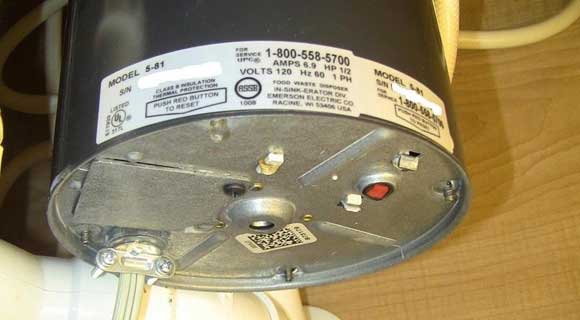Simple Techniques for Repairing a Leaky Garbage Disposal
Simple Techniques for Repairing a Leaky Garbage Disposal
Blog Article
How do you feel in regards to How to fix a pretty consistent leak from my garbage disposal?

Waste disposal unit are crucial cooking area home appliances that assist in throwing away food waste effectively. However, a dripping garbage disposal can be a frustrating and untidy issue to deal with. The good news is, numerous leakages can be repaired easily with a couple of simple steps. In this write-up, we will go over how to repair a dripping garbage disposal properly.
Introduction
Garbage disposals are set up under cooking area sinks and are designed to shred food waste right into smaller sized items, allowing it to go through the plumbing system quickly. While these devices are typically reputable, leakages can take place with time due to wear and tear, loose connections, or damage to the unit.
Common Sources Of Leakages in Rubbish Disposals
Worn Seals and Gaskets
Seals and gaskets play a vital function in stopping water from leaking out of the waste disposal unit. With time, these components can wear away, resulting in leaks around the disposal unit.
Loose Links
The connections between the garbage disposal and the pipes system can become loose with time, causing water to leakage out during operation.
Cracks or Openings in the Disposal Device
Physical damages to the waste disposal unit, such as cracks or holes in the real estate, can likewise cause leakages.
Recognizing the Source of the Leak
Prior to attempting to deal with a leaking garbage disposal, it is important to determine the resource of the leak. This can commonly be done via visual assessment or by conducting basic tests.
Visual Inspection
Check the garbage disposal system very carefully for any type of indications of water leak. Pay very close attention to areas around seals, gaskets, and connection points.
Testing for Leakages
One way to check for leakages is by running water through the disposal system and checking for any kind of visible signs of leakage.
Devices and Materials Needed for Taking Care Of a Dripping Waste Disposal Unit
Prior to starting the repair process, collect the necessary tools and materials, including a screwdriver, adjustable wrench, plumbing technician's putty, substitute seals or gaskets, and epoxy or patching product for fixing splits or openings.
Step-by-Step Overview to Dealing With a Dripping Garbage Disposal
Turn Off the Power
Prior to attempting any kind of repair services, guarantee that the power to the waste disposal unit system is turned off to avoid the threat of electric shock.
Find the Leak
Determine the specific place of the leakage and identify the reason.
Tighten Connections
Make use of a wrench to tighten any type of loose links in between the disposal unit and the plumbing system.
Change Seals or Gaskets
If the leak is due to worn seals or gaskets, eliminate the old parts and change them with new ones.
Patching Fractures or Holes
For cracks or holes in the disposal system, usage epoxy or a suitable patching material to secure the broken location.
Examining the Waste Disposal Unit After Fixing
As soon as the repair is complete, evaluate the garbage disposal by running water through it to ensure that the leakage has actually been resolved.
Preventive Upkeep Tips to Stay Clear Of Future Leaks
To prevent future leakages, it is essential to execute normal upkeep on your waste disposal unit. This consists of keeping it tidy, staying clear of putting non-food items or tough items down the disposal, and periodically looking for leakages or other concerns.
Final thought
In conclusion, fixing a leaking garbage disposal is a reasonably simple process that can be completed with standard devices and materials. By complying with the steps described in this post and practicing preventive maintenance, you can keep your garbage disposal in good working condition and prevent expensive fixings in the future.
HERE’S HOW TO FIX YOUR GARBAGE DISPOSAL
WHAT TO DO IF SOMETHING IS STUCK IN YOUR GARBAGE DISPOSAL
If the impeller won’t turn, there’s probably something stuck in the disposal. It could be a steak bone or peach pit, although plumbers report pulling all sorts of inappropriate objects out of disposals, such as bottle caps or aluminum foil. Make sure power to the disposal is off, and look inside to see if you can see the source of the jam.
Never stick your fingers in a disposal. Pull out anything you see with tongs or pliers.
If the disposal still won’t work, it may be time to call a plumber or consider buying a new disposal. GEM Plumbing & Heating is here for all of your garbage disposal needs.
WHAT TO DO IF YOUR GARBAGE DISPOSAL DRAIN IS CLOGGED
Take everything out from underneath your sink and put a bucket or other container under your disposal to catch any water that drains out. Disconnect your disposal from the power supply. If it’s plugged into a wall outlet, unplug it. If it’s hardwired into an electrical box, go to the electrical panel and turn off the breaker for the disposal. Pour ¼ cup of baking soda into the drain, followed by ½ cup of white vinegar. Give the solution a few minutes to fizz and do its work. Look into the disposal with a flashlight to see if you can see an object that might be causing the clog. If you see it, remove it using tongs or pliers. MORE TIPS ON DEALING WITH A CLOGGED GARBAGE DISPOSAL
Never use drain cleaner in a garbage disposal. It can damage the plastic parts inside the disposal. You can also be splashed with the caustic liquid while working to clear the clog. Beware! Never stick your fingers into a garbage disposal. Trust us — not a good idea. In many instances, your dishwasher drains through your garbage disposal. This allows the disposal to grind any large food particles that may be drained out of your dishwasher. There are some jurisdictions, however, where the plumbing code prohibits such a connection. WHAT TO DO WHEN YOUR DISHWASHER DRAINS THROUGH THE DISPOSAL
Run some water in the sink so your plunger has at least a ½-inch of water to create a seal and plunge vigorously up and down several times. You may need to repeat this several times. Run hot water down the drain to clear any residue that remains.

As a passionate reader about Why Is , I imagined sharing that excerpt was really useful. Those who enjoyed our blog posting please remember to pass it around. Thanks a lot for your time. Visit us again soon.
Schedule Appointment Now Report this page